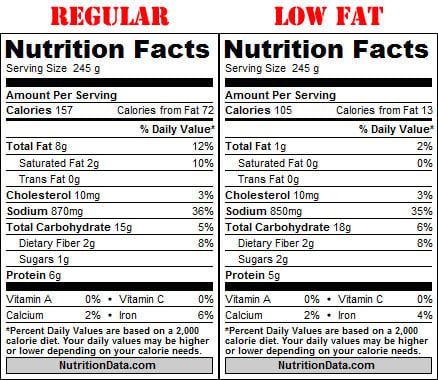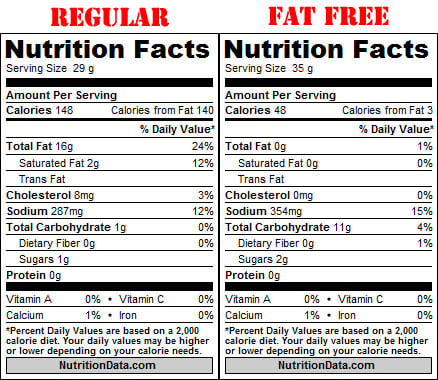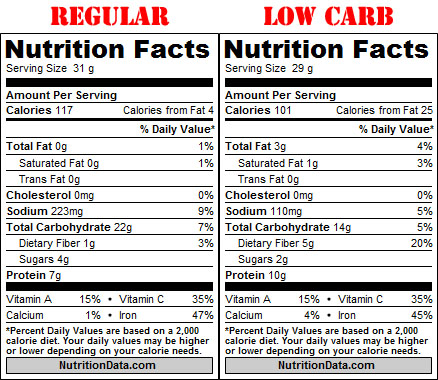Are Low Fat, Fat Free or Low Carb Products Really That Healthy?
I know you've probably seen tons of different products that are low fat, fat free, low carb or carb free and they're all advertised as being a healthy alternative.
But are they really that healthy?
Should you buy into all the carefully crafted marketing and switch to these "healthier" options?
Are these products the missing piece you need in order to achieve your fitness goals?
Let's first take a look at what really makes someone out of shape or overweight.
What makes you fat?
If you find that you're not fit or are gaining a lot of weight there are usually two simple causes for this.
- You're not being active enough.
- You're eating more calories than you burn in a day.

It really is that simple. If you're out of shape it's because of your lifestyle. If you want to lose weight, then you have to do weight loss workouts or be more active and eat correctly for that goal.
So how do you eat correctly in order to lose weight? To put it simply, you have to eat less calories than you burn in a day during your daily activities and workouts. You want to choose healthy foods, so that you fuel your body more efficiently, but you also need to eat less than you normally do in order to drop the fat. Adding in workouts like running intervals helps you achieve your goal even quicker because you'll burn extra calories while you exercise.
So why the fuss about these "healthy" foods?
Now let's look at the food that manufacturers claim to be healthy. One of the most common things you'll find that people do when they see these products is that they'll consume even MORE than before! They think because it's supposed to be healthier that they can eat more of it and they'll be fine.
But you already know that fat and carbs aren't what make you fat. Excess calories from any source are what make you fat. If you overeat, then plan to be overweight.
That's besides the point. Are these product really healthier?
Low Fat
Let's take a look at two products; one's the regular version and one's the low fat version.
The products we're going to be comparing are a common brand of New England Clam Chowder Canned Soup.
I'll break things down by comparing the good and the bad things about the low fat version and you can decide if it's really that much healthier of an option.

THE BAD
- 5 grams less of unsaturated fat per serving; unsaturated fat is good.
- 1 more gram of sugar per serving.
- 1 gram less of protein per serving.
- .4 milligrams less of iron per serving.
THE GOOD
- 52 less calories per serving.
- 59 less calories from fat per serving.
- 2 grams less of saturated fat per serving.
- 20 milligrams less of sodium per serving.
I'd also like to point out that there are 4 more grams of water, per serving in the low fat version of the soup. Let's move onto the next product comparison.
Recommended Reading
Fat Free
Now let's take a look at two different products; one's the regular version and one's the fat free version.
The products we're going to be comparing are a common brand of Ranch Salad Dressing.
I'll break things down by comparing the good and the bad things about the fat free version and you can decide if it's really that much healthier of an option.

THE BAD
- 13 grams less of unsaturated fat per serving.
- 67 milligrams more of sodium per serving.
- 1 gram more of sugar per serving.
- .2 grams less of protein per serving.
- 8.2 IU less of vitamin A per serving.
- .1 milligram less of vitamin C per serving.
- .1 milligram less of iron per serving.
THE GOOD
- 100 less calories per serving.
- 137 less calories from fat per serving.
- 2 grams less of saturated fat per serving.
- 8 milligrams less of cholesterol per serving.
- 1 milligram more of calcium per serving.
- 2 milligrams more of phosphorus per serving.
- 17 milligrams more of potassium per serving.
I'd also like to point out that there are 11 more grams of water per serving in the low fat version. Let's move onto our last comparison.
Recommended Reading
Low Carb
Now let's take a look at two final products; one's the regular version and one's the low carb version.
The products we're going to be comparing are a common brand of Breakfast Cereal.
I'll break things down by comparing the good and the bad things about the low carb version and you can decide if it's really that much healthier of an option.

THE BAD
- 21 more calories from fat per serving.
- 1 more gram of saturated fat per serving.
- 17 IU less of vitamin A per serving.
- .1 milligram less of vitamin C per serving.
- .1 milligram less of vitamin B3 per serving.
- 1 milligram less of vitamin B6 per serving.
- 260 micrograms less of vitamin B9 per serving.
- 4 micrograms less of vitamin B12 per serving.
- 10 milligrams less of betaine per serving.
- .3 milligrams less of iron per serving.
- .6 milligrams less of manganese per serving.
- 9 micrograms less of selenium per serving.
THE GOOD
- 16 calories less per serving.
- 2 more grams of unsaturated fat per serving.
- 113 grams less of sodium per serving.
- 4 more grams of fiber per serving.
- 2 grams less of sugar per serving.
- 3 more grams of protein per serving.
- 3 more micrograms of vitamin K per serving.
- .4 more milligrams of vitamin B5 per serving.
- 4 more milligrams of choline per serving.
- 30 more milligrams of calcium per serving.
- 49 more milligrams of magnesium per serving.
- 127 more milligrams of phosphorus per serving.
- 261 more milligrams of potassium per serving.
- .5 more milligrams of zinc per serving.
I want to mention that for some reason the serving size for the low carb version is 1/4 cup smaller. That's a sneaky trick because honestly how many of you weigh your cereal when you're dishing out a serving for yourself? You'll more than likely go by the amount in your bowl, not how much it weighs.
I hope that after reading this you'll realize that overall calories matter most when your aim is to lose weight. I also hope that you'll look at the label, not just the front of the box, when it says low fat, fat free or low carb; that's not all they change.
As you can see when they lower the fat they take out the bad fat, but they also take out the good fat. And in some products the only fat they take out is the good, unsaturated fat. They also seem to like to raise the amount of sugar and lower the amount of protein when they reduce fat in products. I'm sure you also noticed that when they lower the carbs they jack up the levels of both kinds of fat and change the amounts of vitamins and minerals.
I prefer to eat a balanced diet, not cut something completely out because it's the latest fad. What's more important to you, fitting in or fitting into your pants?










